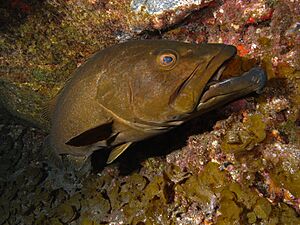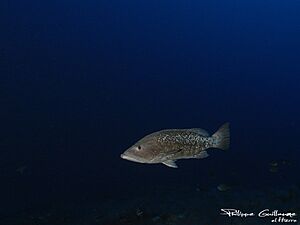Island grouper facts for kids
Quick facts for kids Island grouper |
|
|---|---|
 |
|
| Conservation status | |
| Scientific classification | |
| Synonyms | |
|
The Island Grouper (also called Mycteroperca fusca or comb grouper) is a type of grouper fish. It belongs to the family Serranidae. This fish lives only around the Macaronesian Islands in the eastern Atlantic Ocean. It is listed as a Vulnerable animal on The IUCN Red List of Endangered Species. This means its population is decreasing, and it needs protection.
Contents
What the Island Grouper Looks Like
The Island Grouper is a big fish. Adult groupers are usually brownish or dark grey. They have irregular pale blotches and spots on their bodies. You might also see a clear stripe near their mouth. When this fish feels stressed or scared, it can even change its body color and pattern!
Young Island Groupers look a bit different. They are greenish-brown with clear white spots on their head and body. Their top fin (dorsal fin), bottom fin (anal fin), and tail fin (caudal fin) have white streaks. Their side fins (pectoral fins) are a see-through golden color.
This fish has a body that is long and flat from side to side. It has a rounded area between its eyes. The bones covering its gills (called the preopercle) have large, jagged edges. Its lower jaw sticks out further than its upper jaw.
Young groupers have nostrils that are almost the same size. But in adult groupers, the back nostrils are three times bigger than the front ones. This fish can grow up to 80 centimeters (about 31 inches) long.
Where the Island Grouper Lives
The Island Grouper is a fish that lives only around certain islands. You can find it near the Canary Islands, Azores, Madeira, and Cape Verde. These islands are all in the Atlantic Ocean. In 2010, two of these fish were even seen in the Mediterranean Sea, off the coast of Israel.
Island Grouper Life and Habits
The Island Grouper is a demersal species, which means it lives near the seabed. It prefers rocky areas in the ocean, from shallow waters (1 meter deep) down to 200 meters (about 650 feet) deep. Young groupers often live in tidal pools, which are small pools of water left behind by the tide.
These fish like places with lots of hiding spots, like cracks, caves, and seaweed. This helps them stay safe.
Island Groupers are special because they are "protogynous hermaphrodites." This means they are born female, and later in life, some of them change into males. They gather in groups to lay eggs. In the Canary Islands, they start laying eggs in February and continue until July. These fish can live for a very long time, sometimes up to 30 or 40 years!
They are also active hunters. They explore their territory looking for food. They eat crustaceans (like crabs), cephalopods (like squid), and other fish. Some of their favorite fish to eat include Chromis limbata, Thalassoma pavo, Boops boops, and Similiparma lurida.
Protecting the Island Grouper
The Island Grouper lives in a small area and is not very common. It is especially rare in places where a lot of fishing happens. Studies have shown that when there is more fishing, there are fewer Island Groupers. This suggests that too much fishing (called overexploitation) has greatly reduced their numbers.
The Island Grouper might also face threats from other fish. For example, the European seabass (Dicentrarchus labrax) has escaped from fish farms in the Canaries. This non-native fish might compete with the grouper for food or space. Another fish, the African hind (Cephalopholis taeniops), might have arrived in the Canaries from West Africa in ships' ballast water. This fish could also compete with the Island Grouper or even carry parasites that harm it. Protecting the Island Grouper means managing fishing and watching out for these new threats.



